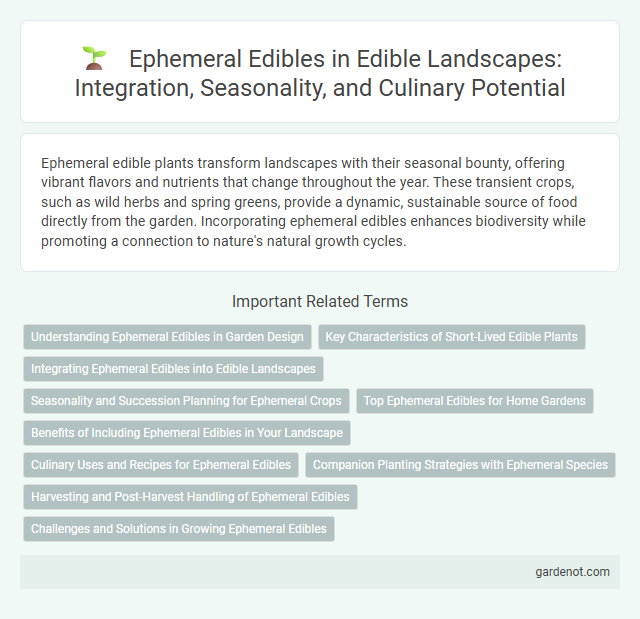Ephemeral edible plants transform landscapes with their seasonal bounty, offering vibrant flavors and nutrients that change throughout the year. These transient crops, such as wild herbs and spring greens, provide a dynamic, sustainable source of food directly from the garden. Incorporating ephemeral edibles enhances biodiversity while promoting a connection to nature's natural growth cycles.
Understanding Ephemeral Edibles in Garden Design
Ephemeral edibles in garden design refer to seasonal or short-lived plants that provide food for a limited time, enhancing both aesthetics and functionality. Incorporating varieties like microgreens, spring garlic, or sorrel creates dynamic, ever-changing edible landscapes that adapt to growing conditions and seasons. Strategic planning of these crops maximizes garden productivity while minimizing maintenance and waste.
Key Characteristics of Short-Lived Edible Plants
Short-lived edible plants in an edible landscape typically exhibit rapid growth cycles, reaching maturity quickly to provide early or seasonal harvests. These ephemeral edibles often boast high nutrient density and intense flavors that peak within a narrow timeframe, making timely harvesting crucial. Their adaptability to varying environmental conditions and minimal resource requirements align well with sustainable gardening practices.
Integrating Ephemeral Edibles into Edible Landscapes
Incorporating ephemeral edibles such as microgreens, wildflowers, and seasonal berries into edible landscapes enhances biodiversity and maximizes harvest variety throughout the year. These short-lived plants provide quick yields and vibrant flavors, complementing perennial crops and extending the functional and aesthetic value of garden spaces. Strategic planting of ephemeral edibles also supports pollinators and soil health, fostering a resilient and sustainable ecosystem within edible landscapes.
Seasonality and Succession Planning for Ephemeral Crops
Ephemeral edible crops require precise seasonality and succession planning to maximize yield and ensure continuous harvest throughout their short growing periods. Implementing staggered planting schedules and selecting crop varieties suited to specific climate windows enhances resilience against weather fluctuations and supports sustainable production. Understanding the life cycles of ephemeral plants allows gardeners to optimize space utilization and maintain soil health through timely rotations and intercropping strategies.
Top Ephemeral Edibles for Home Gardens
Top ephemeral edibles for home gardens include microgreens, radishes, and pea shoots, prized for their rapid growth and nutrient density. These short-cycle crops thrive in small spaces and provide fresh, harvestable greens within two to four weeks. Incorporating ephemeral edibles boosts garden productivity and ensures a continuous supply of flavorful, vitamin-rich produce.
Benefits of Including Ephemeral Edibles in Your Landscape
Incorporating ephemeral edibles such as spring garlic, wild ramps, and purslane into your landscape enhances biodiversity while providing fresh, nutrient-rich harvests that are available early in the growing season. These seasonal plants improve soil health through natural nutrient cycling and attract beneficial pollinators, promoting a balanced ecosystem. Ephemeral edibles also reduce foraging time and contribute to sustainable gardening by minimizing the need for additional inputs like fertilizers and pesticides.
Culinary Uses and Recipes for Ephemeral Edibles
Ephemeral edibles, such as wild garlic, nasturtium flowers, and young dandelion leaves, provide unique flavors for seasonal culinary creations. These ingredients are ideal for fresh salads, vibrant pestos, and delicate garnishes that enhance both taste and visual appeal. Utilizing ephemeral edibles in recipes maximizes the harvest window while promoting sustainable foraging and diverse flavors in gourmet cooking.
Companion Planting Strategies with Ephemeral Species
Companion planting strategies with ephemeral edible species enhance biodiversity and optimize garden productivity by pairing short-lived plants like radishes, lettuce, and arugula with longer-season crops. These quick-growing ephemerals improve soil health, suppress weeds, and attract beneficial insects, creating a dynamic, sustainable edible landscape. Implementing these strategies supports continuous harvest cycles and maximizes space efficiency in small-scale or urban gardens.
Harvesting and Post-Harvest Handling of Ephemeral Edibles
Harvesting ephemeral edibles requires precise timing to capture peak flavor and nutritional value, often within hours or days of ripening. Post-harvest handling involves gentle washing, minimal storage, and rapid consumption or preservation techniques like freezing or dehydration to maintain freshness and prevent spoilage. Proper temperature control and humidity management during storage extend shelf life without compromising the delicate texture and taste of these transient crops.
Challenges and Solutions in Growing Ephemeral Edibles
Growing ephemeral edibles presents challenges such as short harvest windows, unpredictable weather, and rapid spoilage, which demand precise timing and efficient management. Solutions include selecting resilient varieties, employing season extension techniques like row covers, and integrating succession planting to maximize yield and minimize waste. Implementing local microclimate assessments and utilizing controlled-environment agriculture can further stabilize production of these delicate, quick-to-mature crops.
Ephemeral edible Infographic

 gardenot.com
gardenot.com